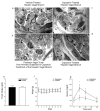An afferent vagal nerve pathway links hepatic PPARalpha activation to glucocorticoid-induced insulin resistance and hypertension
- PMID: 17276352
- PMCID: PMC1899170
- DOI: 10.1016/j.cmet.2006.12.010
An afferent vagal nerve pathway links hepatic PPARalpha activation to glucocorticoid-induced insulin resistance and hypertension
Abstract
Glucocorticoid excess causes insulin resistance and hypertension. Hepatic expression of PPARalpha (Ppara) is required for glucocorticoid-induced insulin resistance. Here we demonstrate that afferent fibers of the vagus nerve interface with hepatic Ppara expression to disrupt blood pressure and glucose homeostasis in response to glucocorticoids. Selective hepatic vagotomy decreased hyperglycemia, hyperinsulinemia, hepatic insulin resistance, Ppara expression, and phosphoenolpyruvate carboxykinase (PEPCK) enzyme activity in dexamethasone-treated Ppara(+/+) mice. Selective vagotomy also decreased blood pressure, adrenergic tone, renin activity, and urinary sodium retention in these mice. Hepatic reconstitution of Ppara in nondiabetic, normotensive dexamethasone-treated PPARalpha null mice increased glucose, insulin, hepatic PEPCK enzyme activity, blood pressure, and renin activity in sham-operated animals but not hepatic-vagotomized animals. Disruption of vagal afferent fibers by chemical or surgical means prevented glucocorticoid-induced metabolic derangements. We conclude that a dynamic interaction between hepatic Ppara expression and a vagal afferent pathway is essential for glucocorticoid induction of diabetes and hypertension.
Figures





References
-
- Berger J, Moller DE. The mechanisms of action of PPARs. Annu Rev Med. 2002;53:409–435. - PubMed
-
- Bellinger LL, Williams FE. The effects of liver denervation on food and water intake in the rat. Physiol Behav. 1981;26:663–671. - PubMed
-
- Benthem L, Keizer K, Wiegman CH, de Boer SF, Strubbe JH, Steffens AB, Kuipers F, Scheurink AJ. Excess portal venous long-chain fatty acids induce syndrome X via HPA axis and sympathetic activation. Am J Physiol Endocrinol Metab. 2000;279:E1286–1293. - PubMed
-
- Bernal-Mizrachi C, Weng S, Feng C, Finck BN, Knutsen RH, Leone TC, Coleman T, Mecham RP, Kelly DP, Semenkovich CF. Dexamethasone induction of hypertension and diabetes is PPAR-alpha dependent in LDL receptor-null mice. Nat Med. 2003;9:1069–1075. - PubMed
-
- Bernal-Mizrachi C, Weng S, Li B, Nolte LA, Feng C, Coleman T, Holloszy JO, Semenkovich CF. Respiratory uncoupling lowers blood pressure through a leptin-dependent mechanism in genetically obese mice. Arterioscler Thromb Vasc Biol. 2002;22:961–968. - PubMed
Publication types
MeSH terms
Substances
Grants and funding
LinkOut - more resources
Full Text Sources
Other Literature Sources
Medical
Molecular Biology Databases

